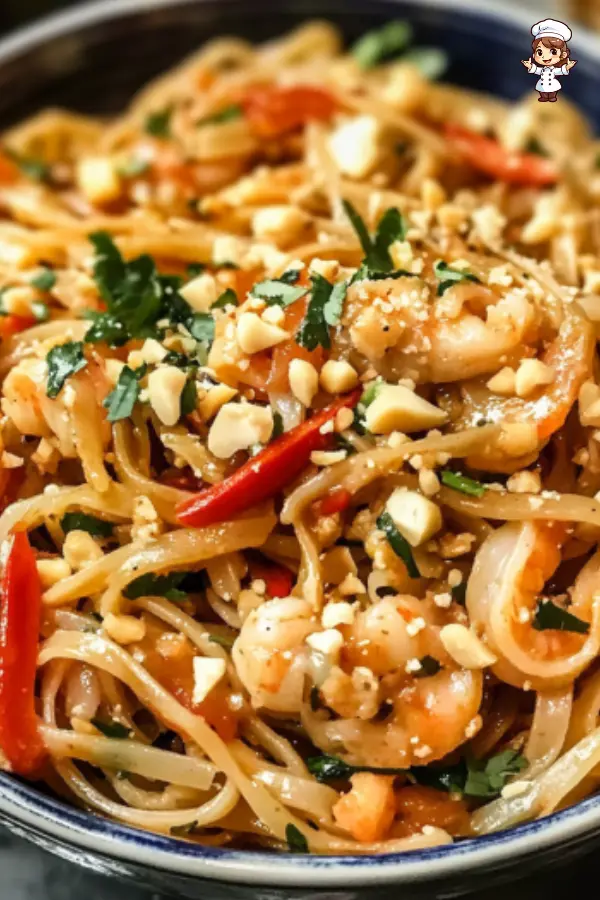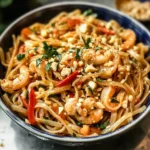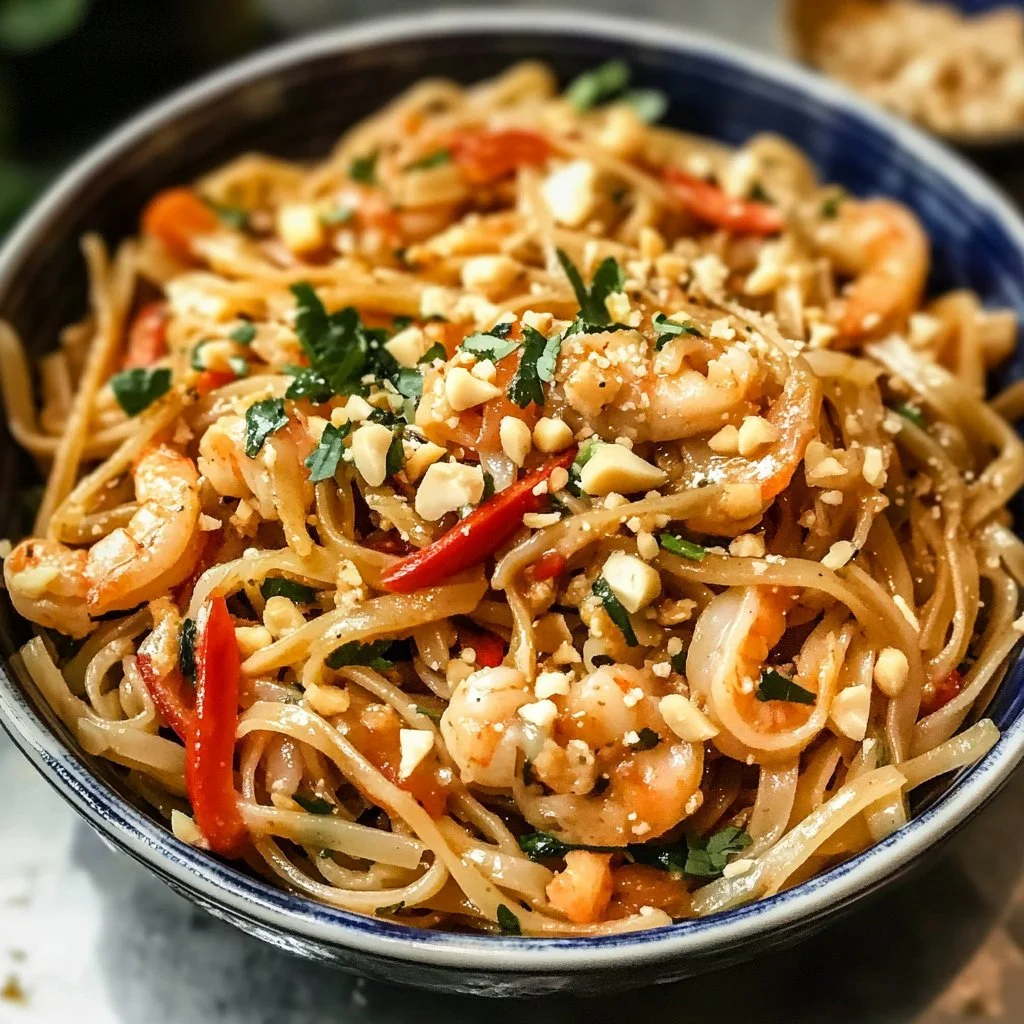Pad Thai is a beloved dish that brings the vibrant flavors of Thailand right to your table. This stir-fried noodle dish is a perfect balance of sweet, salty, and tangy flavors, creating a delightful culinary experience. Originating from the streets of Thailand, Pad Thai has become a favorite worldwide for good reason. It is quick to prepare, customizable, and can be made with various proteins or vegetarian options.
What sets Pad Thai apart is its combination of chewy rice noodles, crunchy vegetables, and your choice of protein, all tossed in a fantastic sauce that brings everything together. Whether you’re a novice cook or an experienced chef, Pad Thai offers a satisfying challenge that’s worth every bite. Let’s dive deeper into what makes this dish so special!
Ingredients about Pad Thai
List of ingredients with measurements
To create a wonderful Pad Thai, you will need the following ingredients:
- 8 ounces flat rice noodles
- 3 tablespoons oil
- 3 cloves garlic, minced
- 8 ounces uncooked shrimp, chicken, or extra-firm tofu, cut into small pieces
- 2 eggs
- 1 cup fresh bean sprouts
- 1 red bell pepper, thinly sliced
- 3 green onions, chopped
- ½ cup dry roasted peanuts
- 2 limes
- ½ cup fresh cilantro, chopped
For the Pad Thai sauce, you will require:
- 3 tablespoons fish sauce
- 1 tablespoon low-sodium soy sauce
- 5 tablespoons light brown sugar
- 2 tablespoons rice vinegar or tamarind paste
- 1 tablespoon Sriracha hot sauce (or more to taste)
- 2 tablespoons creamy peanut butter (optional)
Optional ingredient substitutions
If you want to customize your Pad Thai or accommodate dietary needs, consider these substitutions:
- Use gluten-free soy sauce or tamari instead of regular soy sauce for a gluten-free version.
- Swap shrimp for chicken breast or tofu if you prefer a different protein.
- Add vegetables like carrots, zucchini, or snap peas for extra nutrition and color.
- Replace fish sauce with coconut aminos for a vegetarian-friendly option.
How to Make Pad Thai

Step 1: Cook the noodles
Start by cooking the flat rice noodles according to the package instructions. This usually involves boiling them in water for about 5 to 7 minutes until they are tender. Once cooked, drain the noodles and rinse them under cold water in a colander. This will prevent them from sticking together and keep them nice and moist.
Step 2: Prepare the sauce
In a separate bowl, mix together all the sauce ingredients—fish sauce, soy sauce, light brown sugar, rice vinegar or tamarind paste, Sriracha hot sauce, and peanut butter if you’re using it. Stir well until everything is combined and the sugar dissolves. Set the sauce aside for later use.
Step 3: Cook protein and vegetables
Next, heat 1 ½ tablespoons of oil in a wok or large saucepan over medium-high heat. Add your choice of shrimp, chicken, or tofu and sauté until they are fully cooked. This will take about 5 to 7 minutes depending on the protein used. Once done, add the minced garlic and thinly sliced red bell pepper. Continue to cook for another couple of minutes until the bell pepper becomes tender yet still crisp.
Step 4: Scramble the eggs
Push the cooked protein and vegetables to the side of the pan, creating a space in the center. Add another tablespoon of oil, then pour in the beaten eggs. Scramble the eggs until fully cooked, combining them back into the mixture with the protein and vegetables.
Step 5: Combine everything
Add the drained noodles to the pan along with the pre-prepared sauce, bean sprouts, and half of the dry roasted peanuts. Toss all the ingredients together to ensure that everything is evenly coated in the sauce. Cook for another 2 to 3 minutes, allowing the noodles to soak up the flavors.
Step 6: Garnish and serve
Remove the wok from heat and transfer the Pad Thai to serving plates. Garnish with the remaining peanuts, chopped green onions, fresh cilantro, and lime wedges. Serve immediately while it’s hot and fresh!
How to Serve Pad Thai
Best ways to serve Pad Thai
When it comes to serving Pad Thai, presentation plays a key role in enhancing the dining experience. Serve it on individual plates for each guest, or pile it onto a large platter for family-style dining. The garnish of lime wedges, cilantro, and peanuts makes it visually appealing and inviting.
Serving suggestions or pairings
Pad Thai pairs beautifully with a refreshing drink such as thai iced tea, limeade, or even a light beer. For a complete meal, consider serving it alongside a light salad or spring rolls. The combination of flavors will balance nicely, creating a delightful dining experience.
How to Store Pad Thai
Proper storage methods
If you happen to have leftovers, store them in airtight containers and refrigerate them as soon as they cool down to room temperature. Pad Thai can be safely kept in the fridge for up to 3 days. However, you may find that the noodles absorb some of the sauce, which can alter the texture.
Tips for reheating or freezing
To reheat, place Pad Thai in a skillet over medium heat. Add a splash of water or extra sauce to prevent it from drying out. Stir frequently until heated through. Optionally, you can use the microwave, covering the dish with a microwave-safe lid or film, and reheating in intervals until warm. For longer storage, Pad Thai can also be frozen. Allow it to cool completely, then place it in freezer-safe containers or bags, making sure to squeeze out excess air. It can be frozen for up to a month.
Tips to Make Pad Thai
Common mistakes to avoid
One common mistake in making Pad Thai is overcooking the noodles. Make sure to cook them just until tender and rinse them immediately to stop the cooking process. Additionally, avoid using too much sauce, as it can make the dish soggy instead of flavorful.
Helpful tips for better results
To elevate your Pad Thai, use fresh ingredients whenever possible. Fresh lime juice, cilantro, and crunchy vegetables will enhance the dish’s overall taste and texture. Don’t be afraid to adjust the sweetness, saltiness, or heat from the sauce to your preference. Experimenting with the sauce is part of the fun!
Variation of Pad Thai
Suggested variations or twists on the recipe
While traditional Pad Thai is delicious, don’t hesitate to put your spin on it. You can add different proteins like beef or pork for a heartier meal or make it entirely vegetarian by omitting all meat and using tofu and extra vegetables. Consider incorporating unique ingredients like pineapple or mango for a fruity twist.
Adjustments for dietary preferences
For gluten-free options, use gluten-free rice noodles and ensure all sauces are gluten-free. If you’re vegan, stick with tofu or chickpeas as the protein and replace fish sauce with a soy or coconut amino alternative. The versatility of Pad Thai makes it easy to tailor to various dietary needs.
FAQs
What can I do if the dish isn’t turning out right?
If your Pad Thai isn’t coming together as expected, don’t panic! If it’s too dry, add a splash of water or more sauce during the cooking process. If it’s too salty, add a little more sugar to balance it out. Adjusting flavors as you go can help create a more enjoyable dish.
Can I make this ahead of time?
Pad Thai is best enjoyed fresh, but you can prepare ingredients ahead of time. Chop vegetables, cook proteins, and mix the sauce in advance. When you’re ready to eat, simply toss everything together for a quick meal.
What can I substitute for ingredients?
You can easily substitute proteins in Pad Thai. If you don’t have shrimp, chicken, or tofu, you can use pork or even tempeh. When it comes to sauces, consider using hoisin or oyster sauce if you cannot find fish sauce. Just ensure to adjust the flavors to balance the dish.
In conclusion, Pad Thai is a flavorful and satisfying dish that brings the taste of Thailand into your home kitchen. With the right ingredients and technique, you can create an authentic and delicious meal that everyone will love. Enjoy the process of cooking and, most importantly, dig into your delightful Pad Thai creation!
Print
Pad Thai
- Prep Time: 20 minutes
- Cook Time: 15 minutes
- Total Time: 35 minutes
- Yield: 4 servings 1x
- Category: Main Dish
- Method: Stir-Fry
- Cuisine: Thai
- Diet: Halal
Description
Pad Thai is a classic Thai stir-fried noodle dish known for its perfect harmony of sweet, salty, and tangy flavors. Made with chewy rice noodles, fresh vegetables, your choice of protein, and a flavorful sauce, it’s a quick, customizable, and satisfying meal enjoyed around the world.
Ingredients
- 8 ounces flat rice noodles
- 3 tablespoons oil
- 3 cloves garlic, minced
- 8 ounces shrimp, chicken, or extra-firm tofu, cut into small pieces
- 2 eggs, beaten
- 1 cup fresh bean sprouts
- 1 red bell pepper, thinly sliced
- 3 green onions, chopped
- ½ cup dry roasted peanuts
- 2 limes, cut into wedges
- ½ cup fresh cilantro, chopped
- For the sauce:
- 3 tablespoons fish sauce
- 1 tablespoon low-sodium soy sauce
- 5 tablespoons light brown sugar
- 2 tablespoons rice vinegar or tamarind paste
- 1 tablespoon Sriracha hot sauce (or more to taste)
- 2 tablespoons creamy peanut butter (optional)
Instructions
- Cook the rice noodles according to package instructions (usually 5–7 minutes), then drain and rinse with cold water. Set aside.
- In a bowl, mix the fish sauce, soy sauce, brown sugar, rice vinegar or tamarind paste, Sriracha, and peanut butter (if using). Stir until combined. Set aside.
- Heat 1½ tablespoons of oil in a wok or large skillet over medium-high heat. Add the protein (shrimp, chicken, or tofu) and cook until fully done, about 5–7 minutes.
- Add garlic and red bell pepper to the pan. Sauté for 2–3 minutes until slightly tender.
- Push the mixture to one side of the pan. Add 1 tablespoon of oil to the empty side and scramble the eggs until fully cooked. Mix them with the rest of the contents in the pan.
- Add the cooked noodles, prepared sauce, bean sprouts, and half of the peanuts to the pan. Toss everything together to evenly coat with sauce and cook for 2–3 more minutes.
- Remove from heat. Serve on plates or a platter and garnish with remaining peanuts, green onions, cilantro, and lime wedges. Serve immediately.
Notes
- Do not overcook noodles; rinse them after boiling to prevent sticking.
- Prepare sauce and chop ingredients in advance for quick cooking.
- Customize with vegetables like carrots, zucchini, or snap peas.
- Store leftovers in an airtight container and refrigerate for up to 3 days.
- Add a splash of water or sauce when reheating to refresh texture.
Nutrition
- Serving Size: 1 plate (1/4 of recipe)
- Calories: 520
- Sugar: 15g
- Sodium: 870mg
- Fat: 20g
- Saturated Fat: 4g
- Unsaturated Fat: 14g
- Trans Fat: 0g
- Carbohydrates: 62g
- Fiber: 4g
- Protein: 24g
- Cholesterol: 140mg
Keywords: Pad Thai, Thai noodles, shrimp Pad Thai, chicken Pad Thai, tofu Pad Thai, easy Thai recipe, stir-fried noodles

